Elevator Action
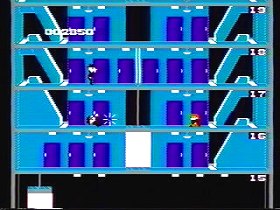 The Game: As a daring spy, you break into a top secret enemy facility, trying to grab vital secrets and evade or kill as many enemy agents as you can. Your only means of getting from floor to floor through most of the game is via the elevator – which gives you an advantage and also makes you vulnerable. (Taito, 1985)
The Game: As a daring spy, you break into a top secret enemy facility, trying to grab vital secrets and evade or kill as many enemy agents as you can. Your only means of getting from floor to floor through most of the game is via the elevator – which gives you an advantage and also makes you vulnerable. (Taito, 1985)
Memories: Almost a dead ringer for its arcade inspiration graphically, the NES edition of Elevator Action actually loses a few points for having lousy sound – something I rarely count off points for, truth be told. But by the time of the NES, the means were there to replicate the arcade sound – take a listen to Super Mario Bros. for proof.
Burgertime
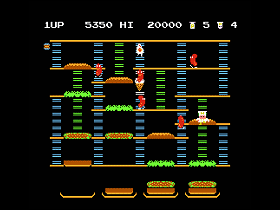 The Game: As Chef Peter Pepper, you climb around a multi-level factory whose sole function is to make some really big burgers. We’re talking about some BIG burgers here. But your ingredients aren’t exactly cooperating with you… (Namco, 1985 [Japan] / Data East, 1987 [US])
The Game: As Chef Peter Pepper, you climb around a multi-level factory whose sole function is to make some really big burgers. We’re talking about some BIG burgers here. But your ingredients aren’t exactly cooperating with you… (Namco, 1985 [Japan] / Data East, 1987 [US])
Memories: A little bit of an oddity – a Data East-originated arcade game ported to the Famicom by arcade competitor Namco (and then sold in the US by Data East itself) – this version serves up a happy meal worth of authentic Burgertime action on the NES.
Toggle
 The Game: Two players’ vehicles start in opposite corners of a confined grid; when moved, each vehicle leaves a light cycle-style trail of that player’s color (red or gold) in its wake. But here’s the twist: the players won’t be eliminated by running over the opponent’s “wake.” Instead, running over the other player’s wake once will knock that portion of it down; running over the resulting gap refills that space with your color instead. The object of the game is to occupy as much of the grid as possible by the end of 45 seconds. (Each game consists of three 45-second rounds, and each successive round adds obstacles such as walls, or gaps through which players’ vehicles can fall, resulting in a delay while that vehicle is replaced.) The winner of the best two out of three rounds wins the game. (1985, Bally [under license from Sente Ltd.] – unreleased)
The Game: Two players’ vehicles start in opposite corners of a confined grid; when moved, each vehicle leaves a light cycle-style trail of that player’s color (red or gold) in its wake. But here’s the twist: the players won’t be eliminated by running over the opponent’s “wake.” Instead, running over the other player’s wake once will knock that portion of it down; running over the resulting gap refills that space with your color instead. The object of the game is to occupy as much of the grid as possible by the end of 45 seconds. (Each game consists of three 45-second rounds, and each successive round adds obstacles such as walls, or gaps through which players’ vehicles can fall, resulting in a delay while that vehicle is replaced.) The winner of the best two out of three rounds wins the game. (1985, Bally [under license from Sente Ltd.] – unreleased)
Memories: After being “put on the beach” by Atari’s new Warner Bros.-controlled management – a term meaning that he was out the door, but still receiving money from a bonus pool that, in Atari’s heyday, was quite substantial – founder Nolan Bushnell was left at a loose end in more ways than one. He began building his new empire, a chain of franchise restaurants called Chuck E. Cheese’s Pizza Time Theatre, which combined food service, robotic characters whose technology Atari had no interest in pursuing and therefore allowed him to retain, and arcade games. Bushnell was still eager to have something to do with the video game industry, but a non-compete clause literally took him out of that game for seven years. In 1985, that clause expired, and Bushnell was ready to get back in the game.
Rush’N Attack
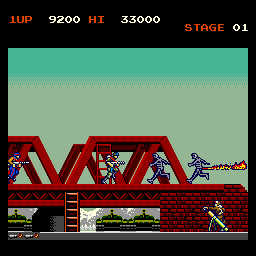
 The Game: You’re a lone soldier behind enemy lines, but this is no Front Line. Armed with a knife and some serious kickboxing skills, you weave your way through an enemy installation, doing away with soldiers who are trying to block your way. Occasionally, you can pick up a weapon from a downed enemy, including flame-throwers, machine guns and rocket launchers. (Konami, 1985)
The Game: You’re a lone soldier behind enemy lines, but this is no Front Line. Armed with a knife and some serious kickboxing skills, you weave your way through an enemy installation, doing away with soldiers who are trying to block your way. Occasionally, you can pick up a weapon from a downed enemy, including flame-throwers, machine guns and rocket launchers. (Konami, 1985)
Memories: I remember encountering only one Rush’N Attack machine, which was one of the last arcade games I ever became hooked on. There’s actually something addictive, in a bloodthirsty sort of way, about this little war game.
Motos

 The Game: This contest places you in a vehicle on a grid suspended in space. Going over the edge of the grid is bad news, and yet that’s exactly where you must ram every other object on the screen. Be careful: Isaac Newton’s laws of motion apply here, and every action begets a reaction, namely your vehicle being bounced as far back as your target has been knocked ahead. And depending on the configuration of the playing field, which eventually evolves to include gaps in the middle of the screen which can only be jumped with the proper combination of “power parts” and “jump parts,” ramming an enemy can put you over the edge too. Later levels introduce more aggressive enemies which will leave you almost strictly on the defensive. (Good tip? Position yourself between two enemies and let the recoil from attacking one help you put another one out of the game as well.) Lingering too long on the playing field will cause whoever’s in charge of this genteel sporting event to hurl projectiles at the field, blasting holes out of the grid which must then be jumped or avoided – and even your own jumps can weaken or destroy other squares on the grid. (Namco, 1985)
The Game: This contest places you in a vehicle on a grid suspended in space. Going over the edge of the grid is bad news, and yet that’s exactly where you must ram every other object on the screen. Be careful: Isaac Newton’s laws of motion apply here, and every action begets a reaction, namely your vehicle being bounced as far back as your target has been knocked ahead. And depending on the configuration of the playing field, which eventually evolves to include gaps in the middle of the screen which can only be jumped with the proper combination of “power parts” and “jump parts,” ramming an enemy can put you over the edge too. Later levels introduce more aggressive enemies which will leave you almost strictly on the defensive. (Good tip? Position yourself between two enemies and let the recoil from attacking one help you put another one out of the game as well.) Lingering too long on the playing field will cause whoever’s in charge of this genteel sporting event to hurl projectiles at the field, blasting holes out of the grid which must then be jumped or avoided – and even your own jumps can weaken or destroy other squares on the grid. (Namco, 1985)
Memories: Say what you like about Namco, but they’ve probably introduced more singularly addictive games to the arcades than any other company out there, and those games cover a more diverse palette than today’s never-ending smorgasboard of fighting and sports titles.
Indiana Jones And The Temple Of Doom
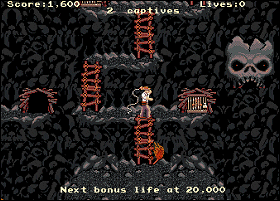 The Game: As famed archaeologist / adventurer Indiana Jones, you enter a vast complex of caverns through one of three entrances (which one determines how hard the game will be). Your first task is to evade and/or whip the Thuggee guards into submission as you free caged children. You then make your escape in a runaway mine cart, which you have to keep on the tracks while also whipping anyone in a pursuing cart who gets too close. After getting the children to safety, you embark on far more dangerous adventures, but with greater risks come greater rewards… (Atari Games, 1985)
The Game: As famed archaeologist / adventurer Indiana Jones, you enter a vast complex of caverns through one of three entrances (which one determines how hard the game will be). Your first task is to evade and/or whip the Thuggee guards into submission as you free caged children. You then make your escape in a runaway mine cart, which you have to keep on the tracks while also whipping anyone in a pursuing cart who gets too close. After getting the children to safety, you embark on far more dangerous adventures, but with greater risks come greater rewards… (Atari Games, 1985)
Memories: Now this is the kind of experience one expects from an Indiana Jones game – kicking butt, grabbing treasure, getting out alive, and avoiding snakes because you hate snakes. It’s by no means a perfect game, but when I need a pixellated Indiana Jones fix, this winds up being my go-to game.
Exed Exes (a.k.a. Savage Bees)
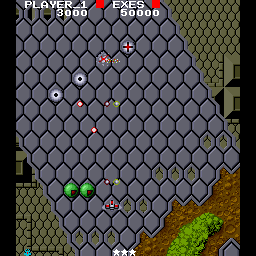
 The Game: Bees are attacking, but they have more than just the sting in their tail, to mix an insect metaphor. These are alien bees with energy weapons and some serious technology to back them up. And guess how many ships are going to fight these buzz-bombers off? You got it – just your ships, one at a time, flying in and blowing up everything in sight. While you’re limited to flying one ship at a time, remember that the bees are attacking in graceful and deadly waves. Occasionally, you’ll encounter “high point areas” where hitting a “pow” marker will transform bees or indestructible skull obstacles on the screen into a fruit that you can collect harmlessly for bonus points. But the bees have a backup plan, too – hive-shaped carriers that appear from time to time, offloading a whole fleet of enemies for you to contend with. (Capcom, 1985)
The Game: Bees are attacking, but they have more than just the sting in their tail, to mix an insect metaphor. These are alien bees with energy weapons and some serious technology to back them up. And guess how many ships are going to fight these buzz-bombers off? You got it – just your ships, one at a time, flying in and blowing up everything in sight. While you’re limited to flying one ship at a time, remember that the bees are attacking in graceful and deadly waves. Occasionally, you’ll encounter “high point areas” where hitting a “pow” marker will transform bees or indestructible skull obstacles on the screen into a fruit that you can collect harmlessly for bonus points. But the bees have a backup plan, too – hive-shaped carriers that appear from time to time, offloading a whole fleet of enemies for you to contend with. (Capcom, 1985)
Memories: I love Exed Exes (released in the U.S. as Attack Of The Savage Bees). But there’s nothing especially original about it, you know? The game play reeks of Xevious, with elements of Mario Bros. (the “pow” power-up) and even Pac-Man (bonus fruit) thrown in for good measure. The enemies appear in waves very much like those of Galaga and Gaplus, even down to their sneaky trick of attacking you from behind at the bottom of the screen.
Dig Dug II
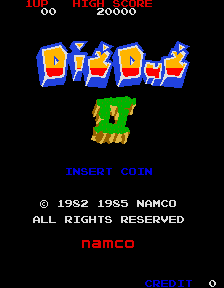
 The Game: Dig Dug is back, and he’s still got a hoarde of Pookas and Fygars to exterminate – or else they’ll ruin his new island garden. Blowing the beasties up with Dig’s trusty pump will still work, but as a last resort, he can also drill into his island’s irrigation pipes and actually sink a part of the land into the sea, taking any enemies with it (and Dig too, if you’re not careful!). (Namco, 1985)
The Game: Dig Dug is back, and he’s still got a hoarde of Pookas and Fygars to exterminate – or else they’ll ruin his new island garden. Blowing the beasties up with Dig’s trusty pump will still work, but as a last resort, he can also drill into his island’s irrigation pipes and actually sink a part of the land into the sea, taking any enemies with it (and Dig too, if you’re not careful!). (Namco, 1985)
Memories: This sequel to one of the most beloved titles from the brief Namco/Atari licensing alliance is virtually unknown, primarily because Dig Dug II hit the arcades after the great video game industry crash of 1983. Honestly, I hadn’t even heard of it until MAME came along.
Targ (Universal Chaos)
 The Game: You’re trapped in a symmetrical maze with a bevy of robotic target vehicles – “Targs” – which are programmed to do just one thing: collide with your vehicle. You have one advantage on these decidedly mean streets, however – you can fire missiles ahead of your car (but the Targs are capable of dodging your projectiles too, so don’t get too cocky). Every once in a while, one of the impregnable blocks in the maze will disgorge a new enemy which is just a little bit faster and deadlier than the rest. Clearing the screen of Targs advances you to a new level with faster enemies – and eventually they’ll put the brakes on your attempts to survive. (CBS Video Games, 1984)
The Game: You’re trapped in a symmetrical maze with a bevy of robotic target vehicles – “Targs” – which are programmed to do just one thing: collide with your vehicle. You have one advantage on these decidedly mean streets, however – you can fire missiles ahead of your car (but the Targs are capable of dodging your projectiles too, so don’t get too cocky). Every once in a while, one of the impregnable blocks in the maze will disgorge a new enemy which is just a little bit faster and deadlier than the rest. Clearing the screen of Targs advances you to a new level with faster enemies – and eventually they’ll put the brakes on your attempts to survive. (CBS Video Games, 1984)
Memories: Exidy‘s offbeat menagerie of arcade games was ripe for licensing in the early 1980s, and for the most part it was Coleco that jumped on that bandwagon, grabbing the rights for games such as Mouse Trap, Venture, Ladybug and Mr. Do, both for their own ColecoVision console and as a third-party title for competing platforms like the Intellivision and the Atari 2600. CBS‘ short-lived entry into the video game market saw them licensing games originating with Bally/Midway (Gorf, Omega Race, Blue Print, etc.), but at one point CBS won the rights to, and advertised, a cartridge version of Targ. The game was completely programmed and ready to go – and then the crash hit.
Super Pac-Man
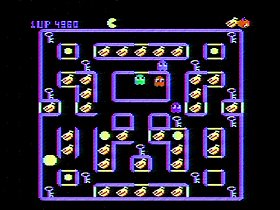 The Game: Once again, Pac-Man roams the maze, pursued by four colorful ghosts. But instead of dots, this maze is peppered with other goodies, ranging from the usual fruits (apples, bananas, etc.) to donuts, cake, and burgers. And in addition to the traditional four “power pellets” in each corner of the screen, there are two green “super power pellets” per screen, which give the mighty yellow one the power to fly over the monsters’ heads and to break down doors that confine some of the yummy treats in the maze. (Atari, 1984 – never released)
The Game: Once again, Pac-Man roams the maze, pursued by four colorful ghosts. But instead of dots, this maze is peppered with other goodies, ranging from the usual fruits (apples, bananas, etc.) to donuts, cake, and burgers. And in addition to the traditional four “power pellets” in each corner of the screen, there are two green “super power pellets” per screen, which give the mighty yellow one the power to fly over the monsters’ heads and to break down doors that confine some of the yummy treats in the maze. (Atari, 1984 – never released)
Memories: Super Pac-Man was one of many Pac-Man spinoffs that made only a minor splash when it hit the arcades in 1982. Nixed by the sudden cancellation of new releases caused by the video game industry crash, Atari’s 5200 edition of Super Pac-Man is actually very good.
Revenge Of The Jedi Game I (Return Of The Jedi: Ewok Adventure)
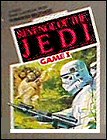 The Game: They’re responsible for the deaths of countless Imperial officers in battle, and served as a vital ally to Luke, Han, Leia and the Rebel Alliance in their darkest hour. Surely every gamer wants to join their ranks and experience the battle of Endor from their perspective! That’s right, you’re an Ewok, flying a primitive hang-glider behind enemy lines, avoiding AT-ST fire and trying to take out as many Imperial troops as you can. Stormtroopers on speeder bikes are both tempting targets and formidable foes for you; if you can, try to fight your way to the Imperial bunker and clear the way
The Game: They’re responsible for the deaths of countless Imperial officers in battle, and served as a vital ally to Luke, Han, Leia and the Rebel Alliance in their darkest hour. Surely every gamer wants to join their ranks and experience the battle of Endor from their perspective! That’s right, you’re an Ewok, flying a primitive hang-glider behind enemy lines, avoiding AT-ST fire and trying to take out as many Imperial troops as you can. Stormtroopers on speeder bikes are both tempting targets and formidable foes for you; if you can, try to fight your way to the Imperial bunker and clear the way 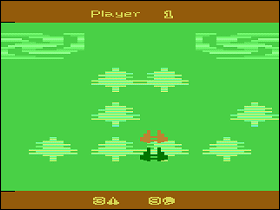 for your friends. Good timing can allow you to temporarily take over the Empire’s walking terrors and use them against their own forces. Face it: you’re a short, stubby teddy bear, armed with rocks, and the fate of the universe depends on you. (Parker Brothers, 1984 – never released)
for your friends. Good timing can allow you to temporarily take over the Empire’s walking terrors and use them against their own forces. Face it: you’re a short, stubby teddy bear, armed with rocks, and the fate of the universe depends on you. (Parker Brothers, 1984 – never released)
Memories: A real curiosity, this was planned to be the fifth in a series of Star Wars cartridges for the Atari 2600, and yet it never saw the light of day. A prototype of the game exists in completed form, as does a prototype of the packaging, bearing the obvious work-in-progress title of Revenge Of The Jedi Game I. (There was a Game II as well, of which more in a moment.)
Garfield
 The Game: You are the world’s most famous lasagna-munchin’ mouser, hopping from fencepost to fencepost, grabbing airborne hamburgers (!!?) and dodging potted plants being thrown at you. Eventually you reach home, where you can antagonize Odie the dog, who has somehow made his way to the top of Jon’s house. (Atari, never released [developed circa 1984])
The Game: You are the world’s most famous lasagna-munchin’ mouser, hopping from fencepost to fencepost, grabbing airborne hamburgers (!!?) and dodging potted plants being thrown at you. Eventually you reach home, where you can antagonize Odie the dog, who has somehow made his way to the top of Jon’s house. (Atari, never released [developed circa 1984])
Memories: Who here didn’t love Jim Davis’ Garfield comics 20+ years ago? I loved ’em. Of course, I too had an unpredictable, feisty, and every-so-slightly overweight striped feline of my own, so I was a little biased. Atari’s unreleased Garfield game fell under the axe of the great video game industry crash, which is a great pity – it would have made a very nice kids’ game, with its easy and not-even-remotely-violent game play (the worst that can happen to you is that you seem to “bulge” when hit by a potted plant). It also had some rather nice graphics, with recognizable renditions of Garfield and Odie.
Cabbage Patch Kids: Adventure In The Park
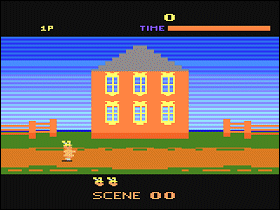 The Game: You are one of those ubiquitously cute icons of the ’80s, a Cabbage Patch Kid, and your mission is to convey your pigtailed self across the screen, circumnavigating whatever dangers await you: rolling balls, puddles of water, and so on. You can jump (and, with the aid of strategically placed trampolines, you can jump really high and snag some high-flying bonus prizes), you can swing across water with ropes hanging from trees, and if you mess up any of the above, you can only do it a few times before you’re a Cabbage Patch Greasy Spot on the ground. Remember, the death of any Cabbage Patch child diminishes the entire Cabbage Patch. (Coleco, 1984 – unreleased prototype)
The Game: You are one of those ubiquitously cute icons of the ’80s, a Cabbage Patch Kid, and your mission is to convey your pigtailed self across the screen, circumnavigating whatever dangers await you: rolling balls, puddles of water, and so on. You can jump (and, with the aid of strategically placed trampolines, you can jump really high and snag some high-flying bonus prizes), you can swing across water with ropes hanging from trees, and if you mess up any of the above, you can only do it a few times before you’re a Cabbage Patch Greasy Spot on the ground. Remember, the death of any Cabbage Patch child diminishes the entire Cabbage Patch. (Coleco, 1984 – unreleased prototype)
Memories: Essentially a copycat of Activision’s Pitfall, Cabbage Patch Kids was originally released on the Colecovision, capitalizing on Coleco’s two big sellers at the time – that console, and the newly-acquired Cabbage Patch Kids doll license. At this point in the 1980s, video game publishers were virtually clueless about what drew women and girls to some games, and repelled them from others, so it wasn’t uncommon to see bizarro licensing moves such as Cabbage Patch Kids and Strawberry Shortcake. Only development on this game was still ongoing when the bottom dropped out of the video game industry, so the Cabbage Patch Kids were strictly confined to the Colecovision until a 2008 flea market find which put this reasonably finished and playable game into the hands of an Atari collector.
Ultima III: Exodus
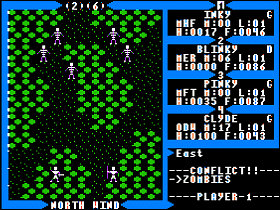 The Game: Darkness has fallen anew upon Sosaria, and Lord British calls for your service again. You set out with four adventurers on a quest to gain the experience that will be necessary to survive the long voyage to a volcanic island where the source of all the evil plaguing the world is said to be. (Origin Systems, 1984)
The Game: Darkness has fallen anew upon Sosaria, and Lord British calls for your service again. You set out with four adventurers on a quest to gain the experience that will be necessary to survive the long voyage to a volcanic island where the source of all the evil plaguing the world is said to be. (Origin Systems, 1984)
Memories: The third game in Richard Garriott’s Ultima cycle, Ultima III was the tops in computer RPGs for ages (at least until Ultima IV came along). Ultima III was the first game in the series to track the movements of the two moons, and the first to feature a part of multiple player characters (as well as parties of evil beings to fight them).
Star Maze
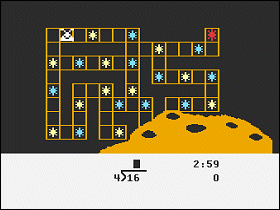 The Game: Poor Thid. He’s lost in space, a long way from home, and he’ll need all of Earth’s intellectual and technological resources to get him home. Or, actually, since he’s on a budget, any old kid with an Atari home computer will do. Solve division problems of varying degrees of difficulty to help Thid return to his home planet, and keep in mind, time is limited for both equation solving and maneuvering. Even if you get your numbers right, Thid can accidentally run into “Badid Stars” that will explode, sending him plummeting into a different part of the star maze. You win the game by returning Thid to his home planet at the bottom of the screen, though if you’re feeling particularly daring, you can take a detour for double points along the way. (Roklan, 1984)
The Game: Poor Thid. He’s lost in space, a long way from home, and he’ll need all of Earth’s intellectual and technological resources to get him home. Or, actually, since he’s on a budget, any old kid with an Atari home computer will do. Solve division problems of varying degrees of difficulty to help Thid return to his home planet, and keep in mind, time is limited for both equation solving and maneuvering. Even if you get your numbers right, Thid can accidentally run into “Badid Stars” that will explode, sending him plummeting into a different part of the star maze. You win the game by returning Thid to his home planet at the bottom of the screen, though if you’re feeling particularly daring, you can take a detour for double points along the way. (Roklan, 1984)
Memories: A clever little educational game for the Atari home computers, Roklan’s Star Maze probably isn’t at the top of anyone’s list except as an Atari completist’s collectible. I’m certainly no big fan of math games, but for some reason I like Star Maze. It’s a nice balance between the educational remit of the software and the board-game-like fun stuff in between the math problems.
Star Wars
 The Game: You’re an intrepid X-Wing pilot participating in the last-ditch Rebel attempt to destroy the Death Star – before it destroys the Rebel base on Yavin IV. TIE Fighters try to intercept you, but you can destroy them (as well as use your own lasers to blast their incoming fire out of the sky). Then you move in to attack the Death Star itself, with its incredibly hazardous system of gunnery towers and bunkers. Once you’ve gotten past the surface defenses, you dive into the trench that will lead you to an exhaust port which is the only means of destroying the Death Star – but there are defenses in the trench as well, and your deflector shields can only take so much… (Parker Brothers, 1984)
The Game: You’re an intrepid X-Wing pilot participating in the last-ditch Rebel attempt to destroy the Death Star – before it destroys the Rebel base on Yavin IV. TIE Fighters try to intercept you, but you can destroy them (as well as use your own lasers to blast their incoming fire out of the sky). Then you move in to attack the Death Star itself, with its incredibly hazardous system of gunnery towers and bunkers. Once you’ve gotten past the surface defenses, you dive into the trench that will lead you to an exhaust port which is the only means of destroying the Death Star – but there are defenses in the trench as well, and your deflector shields can only take so much… (Parker Brothers, 1984)
Memories: In fairness, at the time Parker Brothers snagged the lucrative home video game license for Star Wars, home computers with 64K were still not quite a household fixture (though the Commodore 64 was in the process of changing that). The guts of Atari’s slightly lower-powered home computers were originally designed by the company’s engineers to be their next generation game machine, and the XL series of atari computers was only just being phased in. Faced with these obstacles, Parker Brothers toned down its home computer version of the ambitious Star Wars arcade game, slimming it down to a cartridge with just 17K of code.
Skyfox
 The Game: The invasion is on, and as usual, you’re the only thing standing between Earth and alien domination. (Ever wonder why no one else is answering their pagers at times like these when the call goes out?) Fortunately, your aircraft is a kick-ass piece of military hardware, capable everything from breaking the sound barrier to hovering, helicopter-like, over a friendly installation to defend from an onslaught of enemy tanks. But the enemy makes up for its occasionally lackluster hardware with impressive numbers – and whether the hail of gunfire is coming from their tanks, their jets, or their motherships (which look suspiciously like little Comet Empires from Star Blazers), you can rack up a fatal amount of damage pretty quickly. (Electronic Arts, 1984)
The Game: The invasion is on, and as usual, you’re the only thing standing between Earth and alien domination. (Ever wonder why no one else is answering their pagers at times like these when the call goes out?) Fortunately, your aircraft is a kick-ass piece of military hardware, capable everything from breaking the sound barrier to hovering, helicopter-like, over a friendly installation to defend from an onslaught of enemy tanks. But the enemy makes up for its occasionally lackluster hardware with impressive numbers – and whether the hail of gunfire is coming from their tanks, their jets, or their motherships (which look suspiciously like little Comet Empires from Star Blazers), you can rack up a fatal amount of damage pretty quickly. (Electronic Arts, 1984)
Memories: To my day, Skyfox is still my favorite combat flight sim. Actually, it’s one of my all-time favorite flight sims, combat or otherwise.
Park Patrol
 The Game: Swimmers and snakes and turtles, oh my! Help patrol your beach by picking up litter and saving drowning swimmers while avoiding snakes, sharp sticks, and other obstacles. You’ll need to be quick on your feet (and in your innertube) to succeed! (Activision, 1984)
The Game: Swimmers and snakes and turtles, oh my! Help patrol your beach by picking up litter and saving drowning swimmers while avoiding snakes, sharp sticks, and other obstacles. You’ll need to be quick on your feet (and in your innertube) to succeed! (Activision, 1984)
Memories: In Activision’s Park Patrol, you play the role of a litter-collecting park ranger. Your goal is to keep your lakefront property clean by picking up litter (cans and bottles). To do that you’ll need to use your handy-dandy motorized raft to pick up the trash floating in the lake, and run as quickly as possible to clean up debris lying on the shore itself.
The Newsroom
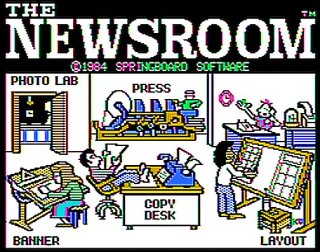 The Game: Not really a game at all, The Newsroom is a primitive – and yet very flexible – example of early desktop publishing. Clip art can be added, or imported from hi-res graphics files. Headline banners and other specialized items can be added as well. (Springboard Software, 1984)
The Game: Not really a game at all, The Newsroom is a primitive – and yet very flexible – example of early desktop publishing. Clip art can be added, or imported from hi-res graphics files. Headline banners and other specialized items can be added as well. (Springboard Software, 1984)
Memories: I know this one really stretches the envelope – after all, Phosphor Dot Fossils is supposed to be about games, isn’t it? – but to me, The Newsroom was the source of so much fun (not to mention instigating some critical early career interests in my teenage life) that it’d be hard for me to not talk about it here.
Music Construction Set
 The Game: If you’re a music lover of any kind, from student level upward, Music Construction Set guarantees that you can make music with the Apple II right out of the box, even with the machine’s puny built-in speaker. A drag-and-drop interface – best used with a mouse and sometimes tiringly clunky with a joystick – allows you to piece together your own music, save it, load it and tweak it later. Several built-in tunes illustrate how to do this. A sound card is almost required, but even with the tinny sound of the Apple II’s built-in speaker the results are surprisingly good. (Electronic Arts, 1984)
The Game: If you’re a music lover of any kind, from student level upward, Music Construction Set guarantees that you can make music with the Apple II right out of the box, even with the machine’s puny built-in speaker. A drag-and-drop interface – best used with a mouse and sometimes tiringly clunky with a joystick – allows you to piece together your own music, save it, load it and tweak it later. Several built-in tunes illustrate how to do this. A sound card is almost required, but even with the tinny sound of the Apple II’s built-in speaker the results are surprisingly good. (Electronic Arts, 1984)
Memories: What I was doing with this, I’ve never quite figured out – I compose in my head and can’t even read sheet music. But it’s still an intensely interesting little program. I never had a sound card for my Apple-compatible machines, but I was still stunned at how good it all sounded coming out of the machine’s native speaker – real live polyphony, it just about knocked my socks off.
The Hitchhiker’s Guide To The Galaxy
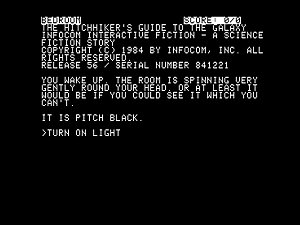 The Game: You’re Arthur Dent, and you’ve woken up with a very bad hangover. Between your state of inebriation and the fact that the Earth will shortly be demolished to make way for a hyperspace bypass, this is an inauspicious start, especially since you must fulfill your destiny as one of the only two human beings left alive in the universe to even begin to get anywhere in this game. (Infocom, 1984)
The Game: You’re Arthur Dent, and you’ve woken up with a very bad hangover. Between your state of inebriation and the fact that the Earth will shortly be demolished to make way for a hyperspace bypass, this is an inauspicious start, especially since you must fulfill your destiny as one of the only two human beings left alive in the universe to even begin to get anywhere in this game. (Infocom, 1984)
Memories: Infocom was the pioneering group of brilliant software designers who took the simple Adventure-style game and elevated it to new heights. By combining an easy-to-use and well-designed interface which understood English, with fascinating worlds created by literate designers and writers, Infocom made some of the most engaging computer games in the history of early silicon.
Frogger II: Threeedeep!
 The Game: Frogger’s back, and he needs your help to do so much more than just cross the road. First, help Frogger navigate an assortment of underwater dangers to reach the safety of a log at the water’s surface, and then help him hop across the backs of various animals and objects to cross the river. Once this is accomplished, you help Frogger ascend to heaven…and then the whole process starts once more. (Parker Brothers, 1984)
The Game: Frogger’s back, and he needs your help to do so much more than just cross the road. First, help Frogger navigate an assortment of underwater dangers to reach the safety of a log at the water’s surface, and then help him hop across the backs of various animals and objects to cross the river. Once this is accomplished, you help Frogger ascend to heaven…and then the whole process starts once more. (Parker Brothers, 1984)
Memories: Officially authorized by Sega (while Sega was still authorized by Konami as the American distributor of the original Frogger), Frogger II: Threeedeep! is a sequel to the hit arcade game – a sequel that never made it into the arcades itself.
Exodus Construction Set
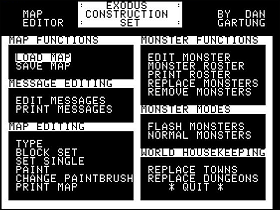 The Game: Would-be digital dungeon masters can reshape the world of the most powerful Apple II adventure game of its era – Exodus: Ultima III – in their own image, from changing the coastlines of Sosaria to changing the behavior of its inhabitants. Cities and townes can be completely redrawn, and the deadliest denizens of the world can be unleashed anywhere. (Dan Gartung, 1984)
The Game: Would-be digital dungeon masters can reshape the world of the most powerful Apple II adventure game of its era – Exodus: Ultima III – in their own image, from changing the coastlines of Sosaria to changing the behavior of its inhabitants. Cities and townes can be completely redrawn, and the deadliest denizens of the world can be unleashed anywhere. (Dan Gartung, 1984)
Memories: With Ultima III acknowledged as the ultimate adventure game for the Apple II by most 8-bit computer RPG enthusiasts, the ultimate challenge was to forge ahead and see the hazardous quest to its completion. And after that? The next challenge was to assume godlike power over the world created by Lord British.
The Adventures Of Buckaroo Banzai Across The 8th Dimension
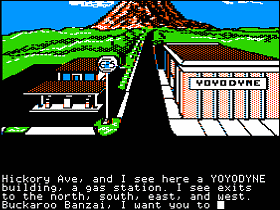 The Game: Players control the actions of rock star brain surgeon (or is that the other way around?) Buckaroo Banzai, who starts the game in Yoyodyne Headquarters and must quickly accumulate the necessary gear to embark on an adventure to fend off the evil Red Lectroid’s latest bid to destroy the Earth. (Adventure International, 1984)
The Game: Players control the actions of rock star brain surgeon (or is that the other way around?) Buckaroo Banzai, who starts the game in Yoyodyne Headquarters and must quickly accumulate the necessary gear to embark on an adventure to fend off the evil Red Lectroid’s latest bid to destroy the Earth. (Adventure International, 1984)
Memories: After virtually starting the home computer adventure gaming craze in the late 1970s, game creator Scott Adams was in a crowded field by 1985. The original Adventure International games – which paired simple graphics with concise, no-nonsense text descriptions – had since been duplicated and surpassed. Sierra On-Line‘s early Hi-Res Adventures were in much the same vein, and Infocom took the text/interactive fiction idea and ran with it sans graphics (at least for a while), but once adventure games were married with real-time action elements (the Ultima series, the Apshai games, King’s Quest, and let’s not forget that whole Zelda thing over on the NES), the days of text-with-illustrations adventures such as those turned out by Scott Adams were numbered.
Zaxxon
 The Game: As the pilot of a lone fighter infiltrating a spaceborne fortress, your mission is simple – survive long enough to vanquish the evil Zaxxon robot hidden deep within the fortress, and take out as many of the defenses as you can in the meantime. (Sega, 1984)
The Game: As the pilot of a lone fighter infiltrating a spaceborne fortress, your mission is simple – survive long enough to vanquish the evil Zaxxon robot hidden deep within the fortress, and take out as many of the defenses as you can in the meantime. (Sega, 1984)
Memories: In 1984, Sega entered the home video game business for the first time, with their first Stateside products being games for the Atari 2600 and 5200. Some of the titles released – Buck Rogers: Planet Of Zoom and Zaxxon specifically – had already been licensed by Coleco for the ColecoVision, and Coleco had even released Zaxxon for other systems such as the 2600. But Sega wanted its own piece of the pie, and not just licensing percentages, when it came time to release more of their properties for home video game systems.
Track & Field
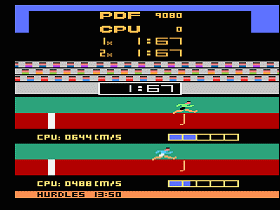 The Game: It’s time for the 1984 Olympics! Qualify and compete in such events as the 100-meter dash, the long jump, javelin throw, and the shot-put. (Atari, 1984)
The Game: It’s time for the 1984 Olympics! Qualify and compete in such events as the 100-meter dash, the long jump, javelin throw, and the shot-put. (Atari, 1984)
Memories: In many cases, Atari faced a major obstacle in licensing major arcade games: the time and money required to secure the license (if it wasn’t already part of an overall deal), and the fact that by skipping the licensing process, Activision or Imagic would virtually always get there first with a more visually pleasing and playable product. But this time, Activision’s sheer speed helped Atari out: The Activision Decathlon practically did some of the R&D for Atari.
Tapper
 The Game: As a beleaguered bartender, you have to serve drinks to an endless onslaught of bar patrons, never allowing them to reach the end of the bar. You must also pick up empty glasses as they slide back toward you, and you can also grab a tip whenever one briefly appears. Clearing the screen of all pixellated hardened drinkers – erm, sorry, soft drinkers – takes you to the next screen, and other scenarios, including outdoor sporting events. (Bally/Midway-Sega, 1984)
The Game: As a beleaguered bartender, you have to serve drinks to an endless onslaught of bar patrons, never allowing them to reach the end of the bar. You must also pick up empty glasses as they slide back toward you, and you can also grab a tip whenever one briefly appears. Clearing the screen of all pixellated hardened drinkers – erm, sorry, soft drinkers – takes you to the next screen, and other scenarios, including outdoor sporting events. (Bally/Midway-Sega, 1984)
Memories: When the U.S. video game industry fell on hard times, Sega sold off its American division to Bally/Midway. Having previously tried to maintain more direct control of home versions of its arcade games through an overall licensing deal with CBS Electronics‘ game division, Bally/Midway now had a more direct pipeline to the consumer market by using the home video game division that Sega had launched to exploit its own arcade titles (such as Buck Rogers: Planet Of Zoom and Congo Bongo).
Star Trek: Strategic Operations Simulator
 The Game: Welcome aboard, Captain. Your mission is to travel from sector to sector, eliminating Klingon incursions into Federation space without getting your Constitution-class starship and her crew destroyed. Friendly starbases offer aid and allow you to make resupply stops so you can keep up the good fight – and you do have to keep a careful eye on your phaser, shield and warp power. Periodically you’ll even have to navigate a minefield laid by the murderous Nomad probe while trying to catch a fleeting glimpse of Nomad itself so you can destroy it. (Coleco [under license from Sega], 1984)
The Game: Welcome aboard, Captain. Your mission is to travel from sector to sector, eliminating Klingon incursions into Federation space without getting your Constitution-class starship and her crew destroyed. Friendly starbases offer aid and allow you to make resupply stops so you can keep up the good fight – and you do have to keep a careful eye on your phaser, shield and warp power. Periodically you’ll even have to navigate a minefield laid by the murderous Nomad probe while trying to catch a fleeting glimpse of Nomad itself so you can destroy it. (Coleco [under license from Sega], 1984)
Memories: One of the better home versions of Sega’s vector arcade game, the ColecoVision edition of Strategic Operations Simulator pulls off the neat trick of very nearly delivering more authentic Star Trek atmosphere than its inspiration. Each game kicks off with the familiar strains of Alexander Courage’s opening fanfare for the Enterprise (replacing the rather non-specific opening music of the arcade game), and even the game-ending “simulation complete” message is accompanied by another passage from the Star Trek theme.
Star Wars: The Arcade Game
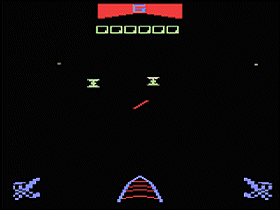 The Game: A long time ago in a galaxy far, far away…you mean to tell me there’s someone out there who doesn’t know this story?! You’re an intrepid X-Wing pilot participating in the last-ditch Rebel attempt to destroy the Death Star – before it destroys the Rebel base on Yavin III. TIE fighters try to intercept you, but you can destroy them (as well as use your own lasers to blast their incoming fire out of the sky). Then you move in to attack the Death Star itself, with its incredibly hazardous system of gunnery towers and bunkers. (Parker Brothers, 1984)
The Game: A long time ago in a galaxy far, far away…you mean to tell me there’s someone out there who doesn’t know this story?! You’re an intrepid X-Wing pilot participating in the last-ditch Rebel attempt to destroy the Death Star – before it destroys the Rebel base on Yavin III. TIE fighters try to intercept you, but you can destroy them (as well as use your own lasers to blast their incoming fire out of the sky). Then you move in to attack the Death Star itself, with its incredibly hazardous system of gunnery towers and bunkers. (Parker Brothers, 1984)
Memories: Just think of it as the original X-Wing vs. TIE Fighter. In one of the strangest licensing deals in early home video game history, Parker Brothers snagged the rights to adapt Atari’s Star Wars arcade game for Atari’s own home video game systems. (If you’re wondering how this worked, it’s because Parkers had the rights to all home video games based on the Star Wars properties – so Atari couldn’t do its own cartridge version.)
Star Trek: Strategic Operations Simulator
 The Game: Your mission is to travel from sector to sector, eliminating Klingon incursions into Federation space without getting your ship and crew destroyed. Friendly starbases offer aid and allow you to make resupply stops so you can keep up the good fight – and you do have to keep a careful eye on your phaser, shield and warp power… (Sega, 1984)
The Game: Your mission is to travel from sector to sector, eliminating Klingon incursions into Federation space without getting your ship and crew destroyed. Friendly starbases offer aid and allow you to make resupply stops so you can keep up the good fight – and you do have to keep a careful eye on your phaser, shield and warp power… (Sega, 1984)
Memories: Some of the games ported to the Atari 5200 are a bit perplexing when they’re hardly a step above the same title as released for the Atari 2600. Sega’s 5200 edition of its own arcade game doesn’t improve much on the graphics of the 2600 version, and doesn’t even take advantage of the 5200’s controller keypad to control things like shields and warp power (that’s actually a bit disappointing there).